So Jesuit Education is the fastest science accelerant I've found, well worthwhile even despite its heavy cost of five social policies. (Mandate of Heaven is a must, and everything else in the tree really doesn't do anything other than feed into Jesuit itself.) What I keep missing in the Jesuit games is the culture and happy from pagodas. I keep claiming that they can't fit alongside the Jesuit buildings within the faith production available... but let's stop blindly claiming that and actually try it. What I've neglected is the continuing faith payback of pagodas: a pagoda bought by turn 100 with Mandate of Heaven pays back its entire faith purchase cost by turn 180.
The Shoshone Jesuit game actually did come pretty close on having what would have been enough faith for the pagodas. The difference between that and the Poland Jesuit game was the amount of desert. Poland had several cities that weren't in desert at all, and civ-wide was working maybe 50% desert tiles. Shoshone had more, closer to 80% of worked tiles, and got noticeably more faith. I think the pagoda math does indeed work out if we can get enough desert.
Here's some math. To satisfy the requirements for a pagoda plus the three Jesuit buildings for a city costs 160 + 160 + 320 + 480 = 1120 faith. The relevant timespan is approximately 70 turns, from about turn 90 to 160, from when the religion is fully spread and we start spending on pagodas until when we want to have all the research labs done. 1120 faith over a timespan of 70 turns is 16/turn. A city produces 7 faith from buildings (shrine/temple/pagoda), leaving 9 to be produced from Desert Folklore terrain. Therefore, if a city by turn 90 can work 8 desert tiles plus the city center, it is net positive on faith production throughout the game. We can go as wide as we want on such cities.
Wider is better for science... until you hit the limits of happiness. My wide Shoshone game went a bit too far there, stuck without growing for too long, fifteen turns or so in the midgame. Pagodas will help, but my feeling is that even they wouldn't have been enough to completely relieve that constraint. Still need to find a bit more.
There's one civ with a strong happiness component that I haven't used in forever since vanilla Civ 5: Egypt. Temple UB that adds 2 happy. I've always disregarded this since temples aren't very efficient and come too late down the build order. But the Piety - Jesuit game plan brings temples right up to the beginning front and center. Perfect. In fact, I'm going to gear the entire religion for maximum happy: stack up all of Egypt's Burial Tomb, Pagodas, and Religious Center, for a total of 6 happy per city. That should be enough to go just about as wide as I can physically reach.
Of course, Egypt's UA of +20% to wonder production is also solidly strong. So is the UU, a chariot archer with an extra move and no horse requirement, we'll want some of those to go clear camps and retrieve workers for city-states. Egypt might be the one civ with enough power to challenge the reigning kings Poland and Shoshone.
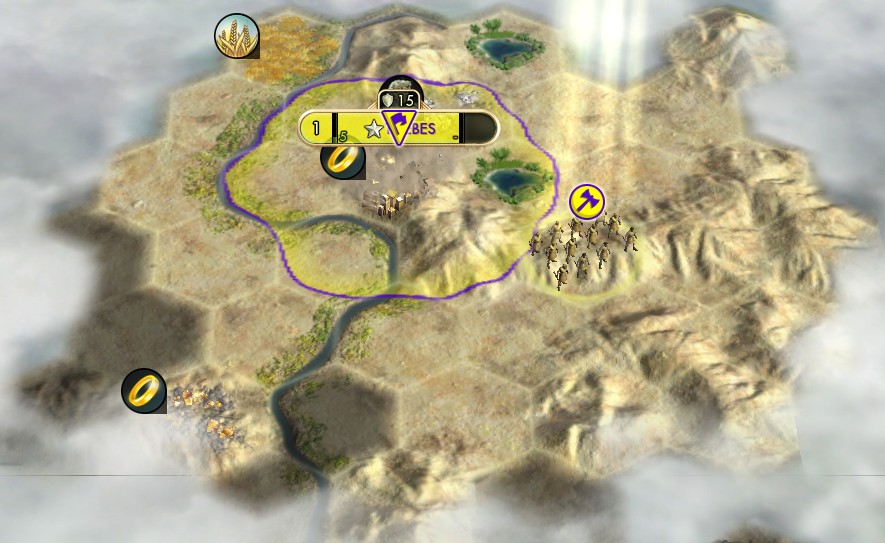
Good mix of stuff here. 3-food tile in first ring, three more in outer rings (one more oasis still fogged), on gold, also marble. The one thing it's missing is easy hills; they're all in the outer rings so we will have to buy them.
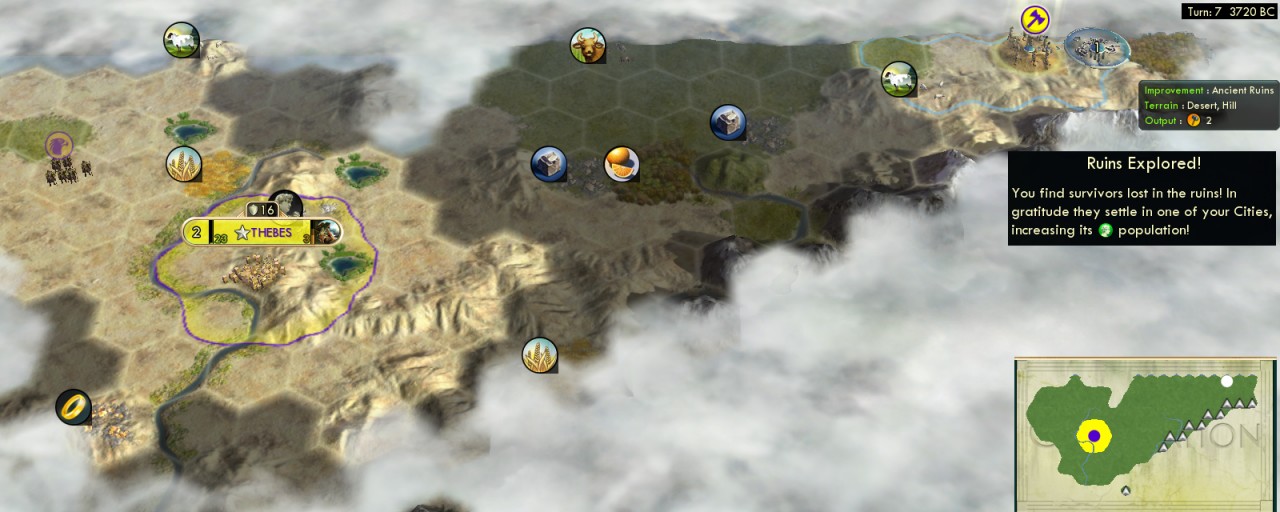
I was slow to start finding ruins, thanks to that rather ridiculous wall of mountains hemming in my exploring warrior. But the very first one here gave the magical population result.
This theme would continue. I got scant few ruins by my standards, but they paid out just enough to make the game playable. I got the one population, one culture ruin (turn 13), one tech (Archery), two gold (85 and 65), two maps (actually pretty helpful)...
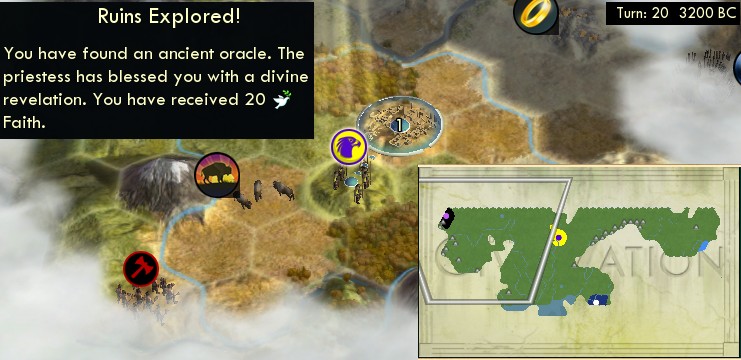
and right on miraculous schedule, that one all-important faith ruin for the Desert Folklore pantheon.
Money came slightly slowly too thanks to few nearby city-states. But between the gold plant, oasis, and France paying 5/turn for my gold early on turn 16, I got the first worker purchase in good time on turn 21.
Why was I so tolerant of this mildly slow start?
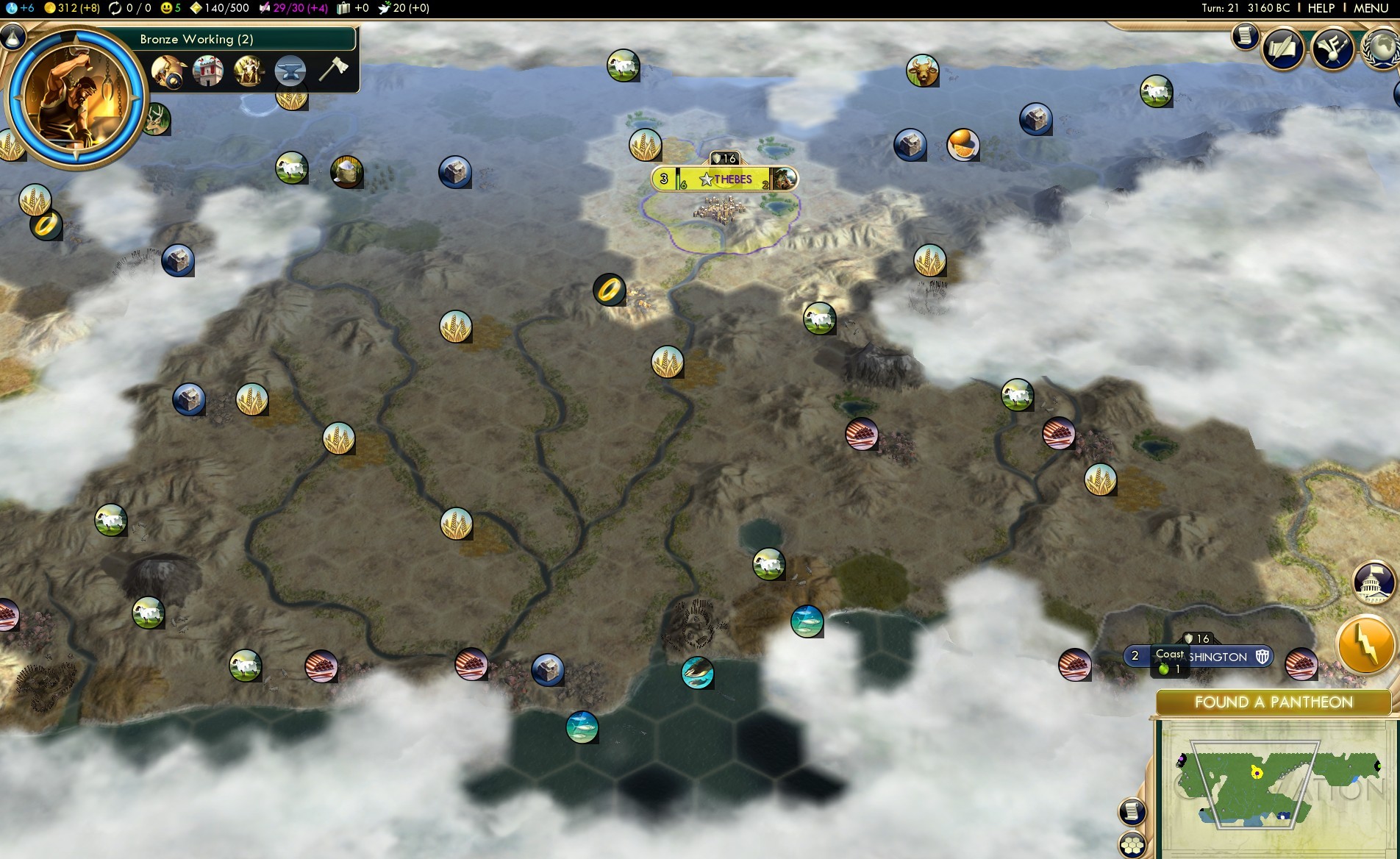
This. What a gorgeous map. I've got your Breathtaking scenery right here. Vast desert fertile with rivers. Four more reachable luxuries beyond the two at the capital. Plus enough coastal access for full sea trade routes, and even in locations with enough hills to build the cargo ships. (Just gotta beat America to the whales.)

The lack of hills at the capital had this consequence, highly unusual in my speed games. I grew the capital from size 3 to 4 normally. Usually I work all available hills to burn food surplus into hammers, but that couldn't happen here. The cost looks like 33 food, but the opportunity cost is really just 22 hammers, since the tradeoff is between 3-food or 2-hammer tiles. 22 hammers is a noticeable setback on building scouts, but the extra city size would make up for that during the starvation settler phase.
Policies: t13 Liberty opener, t22 Republic, t37 Collective Rule. A bit slow to that last (it can come 10 turns sooner with more culture ruins) but I tolerated it.
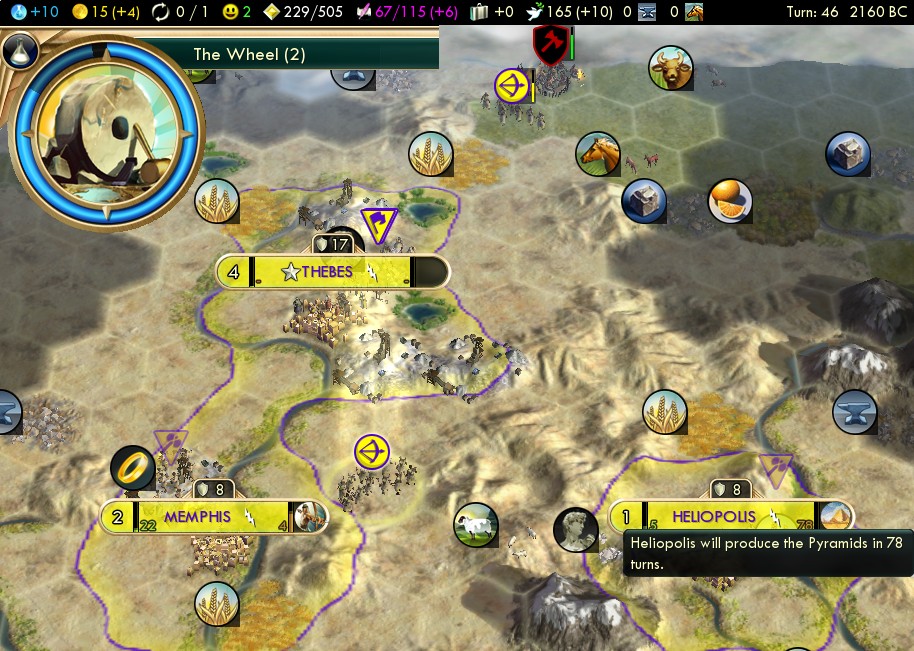
We started expanding of course. Memphis was the Collective Rule settler, placed to get the gold hill within workable range of Thebes without buying it. Heliopolis is at a nice location with marble that would help my favorite move of building the Pyramids in a side city to not occupy the capital's build queue. And I had just enough gold to buy a worker for it.
So the build order was three scouts - monument - one more scout - archer - worker - archer - settlers. That one more scout was specifically for this task:
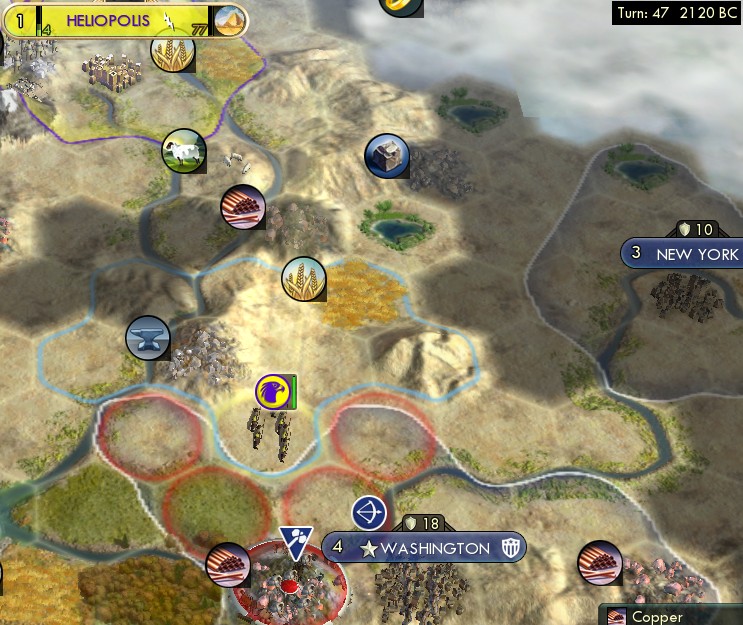
Go steal a worker from America. It took that scout several extra turns to get here thanks to barbs, then another ten until America actually deployed a worker (they built the settler for New York first.) But we got it here. My scout died on the return shot (92 damage from the city! I'd thought it would survive), but the worker got away. Besides the worker itself, this attack was also deliberately to cripple America and make sure I'd settle all of the desert ahead of them.

I was a little worried about dealing with any military America might have. Memphis' first build order was an archer, that started moving in that direction. But then a militaristic city-state that I'd friended from a camp clear provided a spearman, the perfect unit in the perfect place at the perfect time. So perfect that this happened immediately next:

I seldom curse here, but HOLY FUCK! A free size 3 city! Uh, now I see why the Realms Beyond folks were telling me to abuse the AI more. Holy crap. It's not like I could really do anything more to hurt America - nowhere near enough units to capture their capital. But the AI can only see its feeble military strength compared to its strong enemy and so becomes desperate for peace.
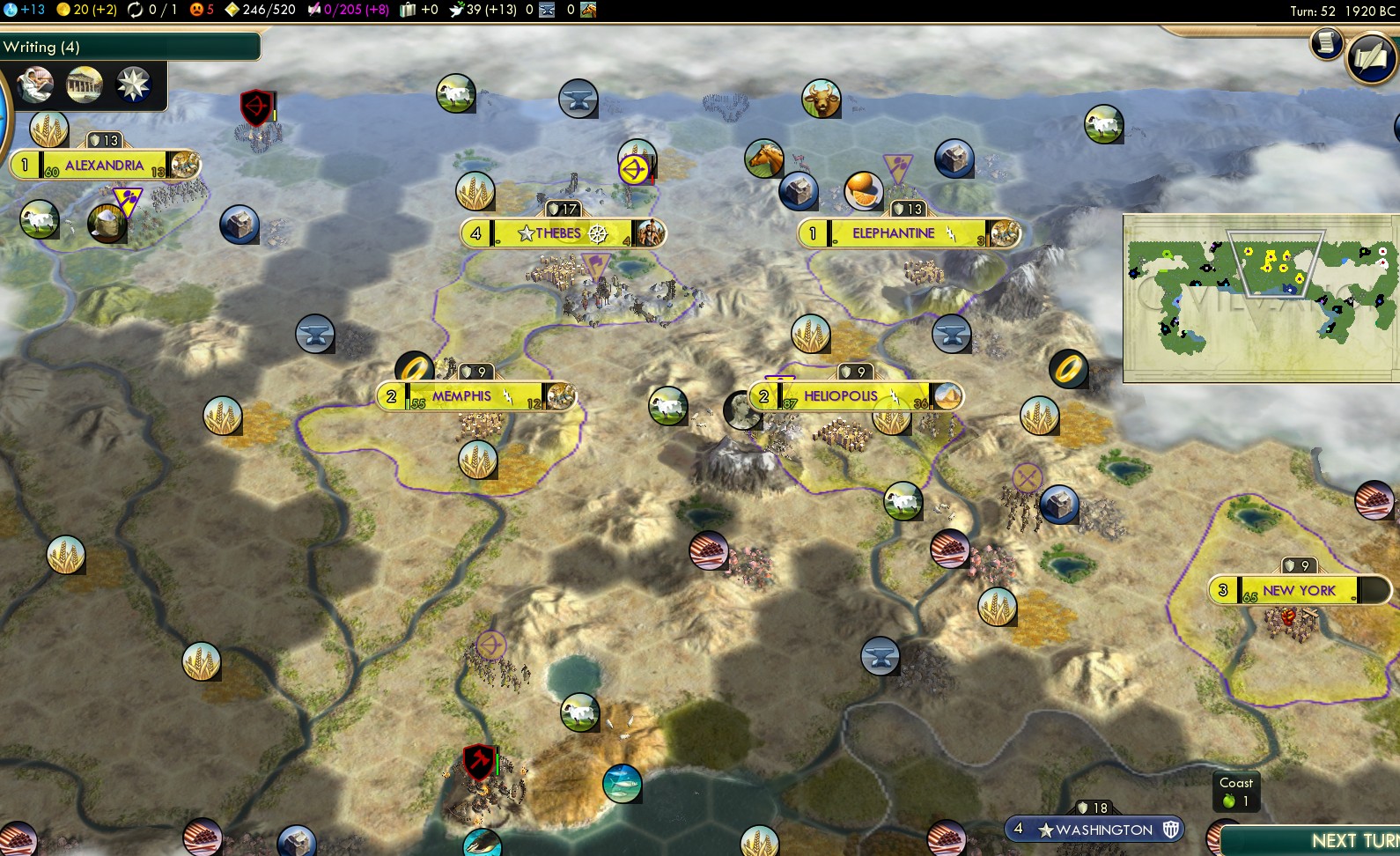
Okay, New York wasn't a great city. No resources, didn't get Desert Folklore, and with no hills would take forever to build anything. But damn, I couldn't pass up that chance. Just the 3 beakers is a significant boost, and it's one less settler to build from the capital.
New York would cause anger trouble. But I was well set to deal with it. Founding Alexandria intentionally dropped me into unhappiness this turn anyway, necessary for a few turns until the sugar there and citrus at Elephantine could be improved. And then those luxuries together would be enough happy to sustain New York. It would have to stay puppeted for a while, but its build choices were shrine and library, both of which were fine by me. I eventually annexed New York when it started a watermill (it didn't need more food) and I had a happy cushion, and wanted to buy a pagoda there to get it expanding towards its copper and horses.
For the rest of the cities, a few turns of anger was OK for the moment. Most were working hammer tiles anyway to build military then workers. It doesn't help to grow onto an unimproved flood plain, that only feeds itself with no productivity gain. Also, this was the critical moment where religious pressure just started, and it was helpful to keep a city or two (particularly Elephantine) at size 1 until it converted.
Those are War Chariots under production in all of Memphis, Elephantine, and Alexandria. That's another part of the Egypt game plan, to use these fast and strong units to go out and fight barbarians for city-state favor.

It's not worth chronicling them all, so here's a quick montage of cleared camps and retrieved workers. For all the usual goodies in reward, including resources that cascaded into more quests. This is a major difference on Prince difficulty: city-states lose a lot more workers to barbarians, since they have far fewer units to recover them. It's notable that I kept the worker from Sofia in the first one and eventually walked it home; Sofia was a hostile personality, and militaristic where alliance isn't really any better than friendship.
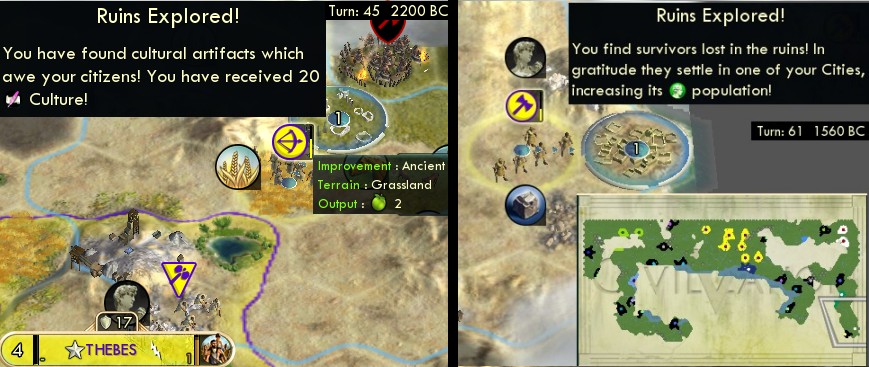
Also some late ruins. (Yeah, I took 45 turns to go walk four tiles north of my capital.) I hoped for a miracle population in the capital from that first one, but just got culture. The other one in the southeast delivered population, actually a bad result: it went into puppeted New York where it cost more anger and was least useful, and it knocked me from 0 to -1 happy that turn. But fortunately the next turn I popped a natural wonder to make up for it. Other late ruins elsewhere yielded 80 gold, another archer upgrade, Trapping, and Calendar.
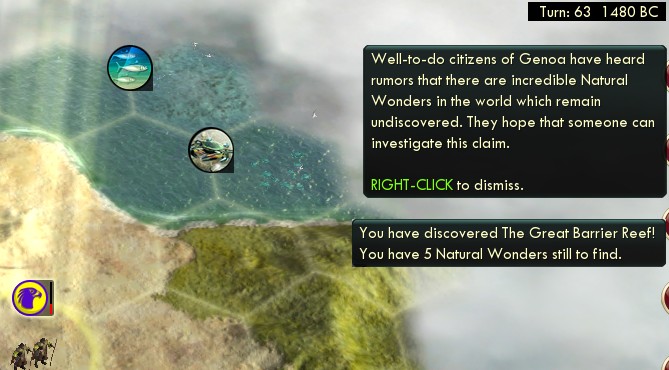
And from the stupid easy quest department, we have Genoa calling for a natural wonder right after we just discovered half of the Great Barrier Reef, meaning the other half to satisfy the quest is literally one step away.
The important incidents were these two.

Here's a godstorm of ways to please a city-state. First I killed a barbarian. Then I bought embassy with England to satisfy that discovery quest. Then I positioned my war chariot to block Vancouver's worker's retreat so that it would run into that hand-axe. Then I killed the hand-axe too and retrieved the worker. Finally I cleared the camp on the far side, all adding up to a massively permanent maritime alliance.
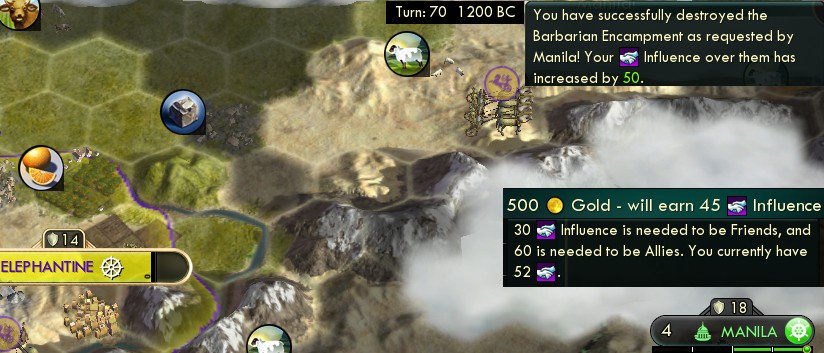
And this one. It was just a routine camp clear, no worker or anything else involved... and so I decided to spend money buying Manila into alliance. It's totally worthwhile here, turning that 50 influence into a long alliance. Manila was friendly, and would get my religion for the influence decay bonus as well. I didn't expect to get to retrieve any workers for Manila (sheltered by the mountains and my own territory), but later it did happen on the far side anyway and I had another gamelong maritime ally.
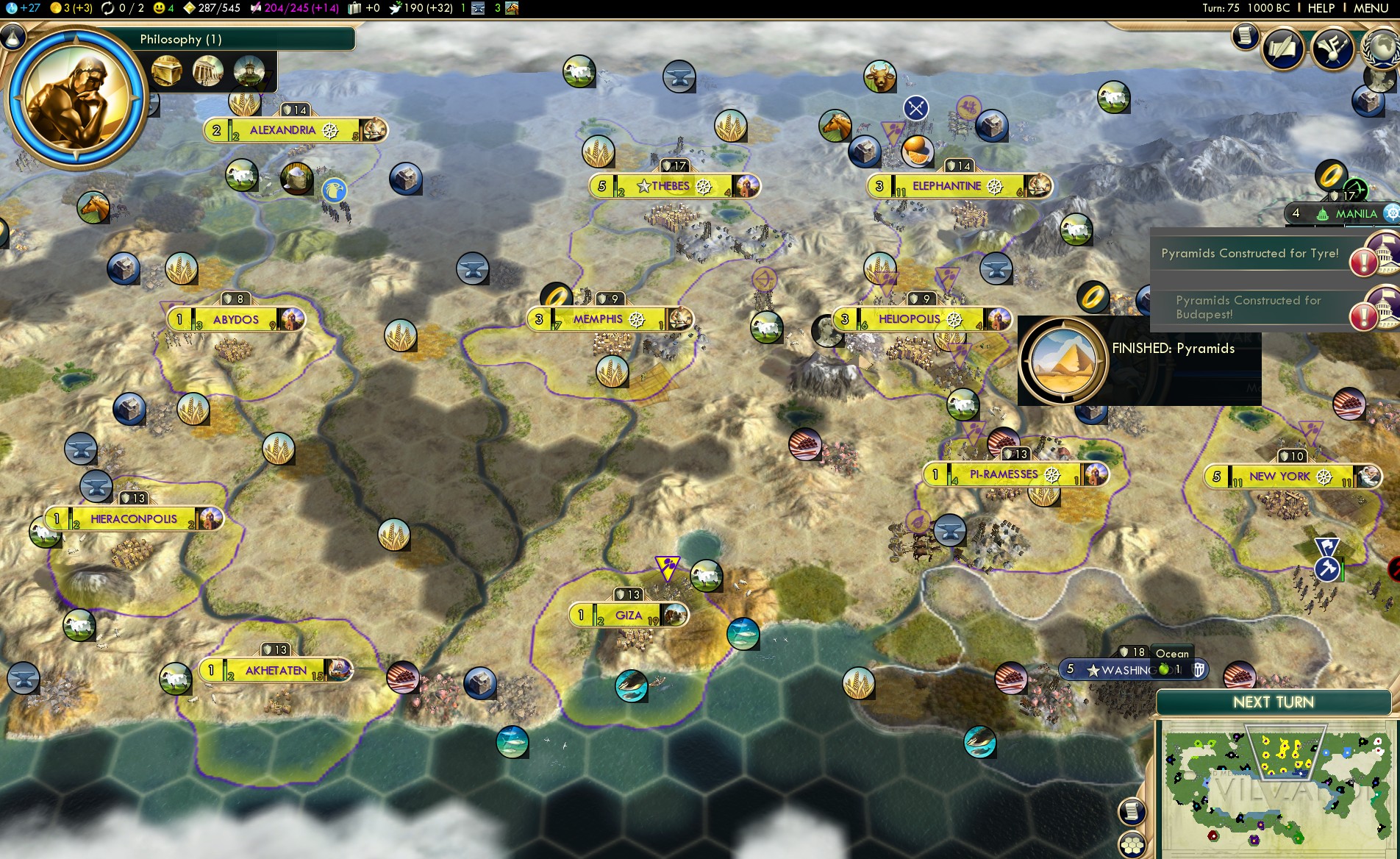
My capital built settlers on the starvation plan as always. Here I am out to 11 cities and 26 population by 1000 BC. Not a record (Greece 39 pop), but I have the maritime allies to ramp up now, particularly in the absence of Feed the World.
I thought a bit more about the math on the settlers here. My capital could produce 12 hammers at breakeven food, or 27 hammers into a settler with the starvation loophole and Collective Rule multiplier. This means that the true functional hammer multiplier for settlers is 27 / 12 = 225%. Equivalently, the base hammer cost is 106 / 225% = just 41 base hammers! In other words, the productivity spent into a settler represents just 41 hammers of opportunity cost into something else.
That represents the fastest payback period of anything in the game. With Republic, founded on a hill and working a hill, a new city produces 5 hammers. That pays back the settler's build cost in less than ten turns! It's better payback than any granary or trade route or Feed the World shrine or even workers. This is why I keep finding that expanding with settlers as fast as possible outperforms any other early plans like wonders or anything else like the National College. Even better if you have maritime food to figure in as well.
Well, that expansion party goes only as far as the happiness does. This is what I've done wrong in a few games, including the last Shoshone one that went too wide to 14 cities. I also had one partial start with this Egypt game plan that I abandoned for running into too much unhappiness. But I got it right this time. I had six luxuries of my own, plus a few from city-states and AIs.
But I made this critically correct move right now: I stopped spamming cities from my capital here after 11. I needed just a little break on planting cities to give a little time to ramp up on pagodas and Egypt's temples. Also, the cost of settlers had gone up. How? The two maritime allies were now providing 6 food in the capital. That meant the starvation loophole no longer gained 6 extra factors of production. The capital could now produce 18 hammers at breakeven food. Settlers no longer had an effective 27/12 multiplier to cost 41 base hammers of opportunity cost, but 27/18 to cost 71. Plus Thebes had just started WLTKD which would be even more opportunity cost in not growing.
But I wasn't done expanding. The whole point of the max-happy Egypt game plan is to go wide, wide, wide. I knew I'd have dozens more happy headroom once all the pagodas and burial tombs completed. But where would I get the settlers?
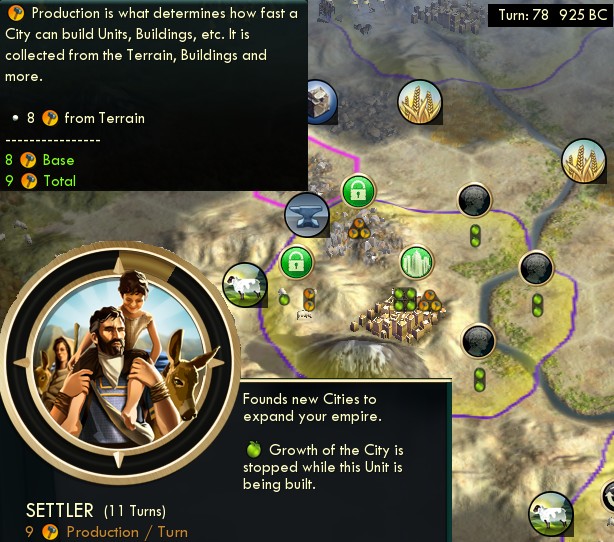
Answer: just build them. It's actually not hard. This size-2 city here can work hammers and put one out in just 9 turns (aided by a turn's worth of doubled overflow from the shrine.) And doing it this way means the settler is produced much closer to where he'll settle rather than spending fifteen turns walking from the capital. So after my first 11 cities, I built four more settlers from side cities like this one.
However, I finally realized and solidified a thought about one downside of going wide. Workers. You have to build them once you go beyond about 10 cities. You typically come by about 10 workers from various sources: early buys, Pyramids, city-state steals, scavenging from barbarians. These support 10 cities with no real invested effort, but beyond that you have to build workers yourself. I did that correctly here, building about five out of various cities and keeping pace on improving tiles... but delaying their build queues by those 70 hammers was a noticeable setback.

Religion: It began on a standard schedule, Desert Folklore right away on turn 20, then the prophet on turn 51 for beliefs Tithe and Pagodas. One missionary followed, necessary to convert Heliopolis and New York which were too big to wait for pressure, but as always the pressure from those would convert everything else. The first pagoda came on turn 76, just after the previous overview. Then as more pagodas and burial temples completed, I had enough happy headroom to pause on pagodas for a moment to get the enhancement prophet on turn 96 to take Religious Center and Reliquary.
Ah, pagodas. I missed them recently, been a few games since I've gotten to spam them. They really provide that happiness breathing room at the most critical time, the kink as we enter the steep part of the S-curve, with all the cities founded and ready to burst with growth if their hunger for happy can be satiated. I was already at 50 faith per turn to buy them at 4-turn intervals now, and that would shortly decline to intervals of three and even two turns as my faith production passed 100 with Piety and Organized Religion now active on shrines and temples.
That brings me to policies. The Piety opener came on turn 52, Organized Religion on t78, Religious Tolerance on t95. I mistimed the Oracle a bit (expected Religious Tolerance a bit later and underestimated how much the pagodas would shorten that), but then it completed on turn 100 to land the Reformation for Jesuit Education. Mandate of Heaven followed on turn 107.
It turned out that I actually bought all of the available pagoda slots before Mandate even came. This whole expansion phase felt like playing a Sacred Sites game! Just spam cities to get faith to buy religious buildings to enable spamming more cities for more faith for et cetera.
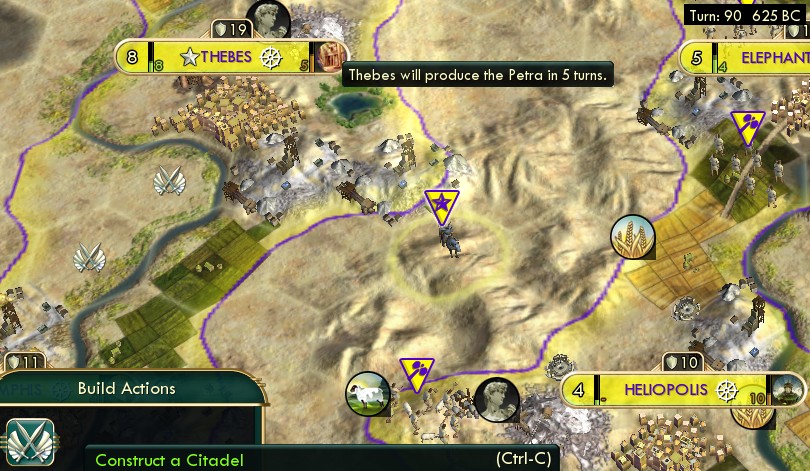
I got a startlingly early Great General from barbarian combat. Had no idea I was anywhere near that. I pulled this sweet move with him: plant this citadel to grab five desert hills without having to buy them, saving over 600 gold worth of purchases!
And Thebes is on the verge of Petra there. My capital also developed better by ceasing to build settlers earlier than usual. Often I go straight from settlers to Petra, skipping intermediate infrastructure like the granary, shrine, library. This time Thebes built those before Petra and also grew several sizes. After Petra came the aqueduct and then it was fully ready to rocket on growth.
Also I bought a third maritime city-state ally when my money accumulated up to 500 during the happy Golden Age.
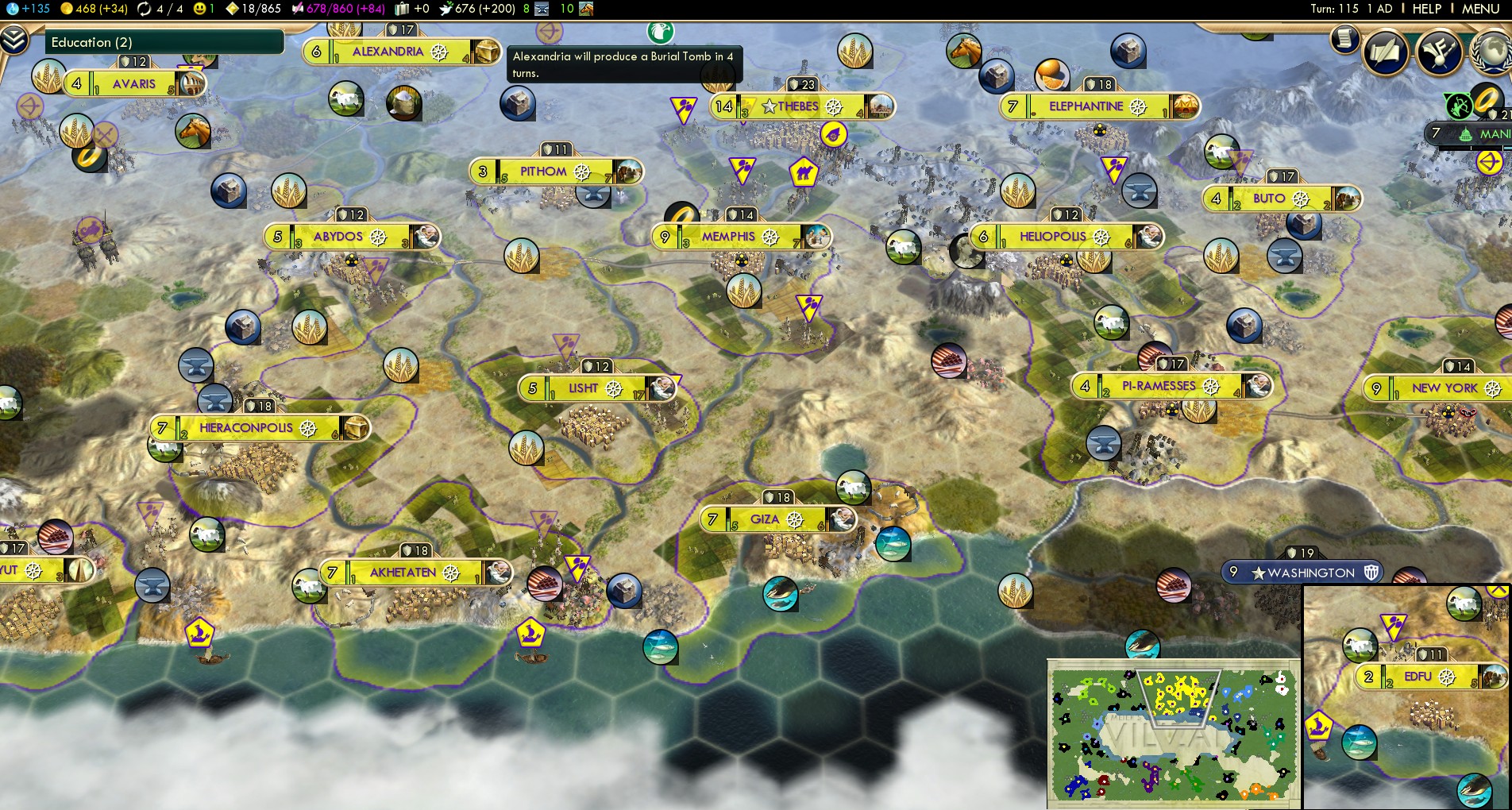
Moving on to the next overview. At 1 AD, I have 104 population, and two turns from Education. Civil Service had come on turn 106.
This actually sucked. Despite the wider number of cities (17), this 104 population was barely more than Shoshone (100) and Poland (98). And Civil Service and Education came ten turns slower! I was making excuses to myself that I didn't know why, but frankly I do. About half of it came from the slower start, spending an extra five turns growing the capital before settlers and Collective Rule. About three turns worth of beakers was lost by missing the Great Library (it fell on turn 60, very early for Prince), and another two from not building regular libraries early enough. Well, time to see if having 50% more cities than Poland can in fact make up some of that ground by the end of the game.
In the happiness department: recall how I set up this whole game plan for maximum happy, Pagodas and Burial Tombs and Religious Center each accounting for 2 per city. My goal was to never run out of happiness and have to pause city growth. I almost succeeded in that. Right here at 1 AD, I'm crunched at the happy cap with just a few cities stalled for just a few turns.
That happened because I got a little overconfident. While expanding to all those cities, I had been riding high at 12, then 15, as high as +18 surplus happy. I started thinking I wouldn't even be able to consume all of that, and neglected burial temples for a while (remember 4 happy each with Egypt and Religious Center) in favor of granaries and aqueducts and more settlers.
Nope. As always, it turned out that there is no quantity of happiness that a wide civ can't exhaust. And right at this moment, I couldn't build more temples, as we needed the libraries on the eve of Education and Jesuit universities. So there was a slight pause to growth, but nothing severe. I got more temples done a few turns after that picture, and also realized I had never dealt with New York's courthouse and bought that next.
As for the Jesuits, the timeline worked out that I bought all the pagodas and spawned the 500-faith prophet before Education, but couldn't reach the 800-faith prophet or Hagia Sophia in time to raise the ceiling further. So I carried just under 800 faith into Education and instabought five Jesuit universities. Not great, compared to the Shoshone with 1600 faith for ten. That means we're another four or five turns behind to the 9th or 10th university, which ultimately becomes the limiting factor in spawning what is to be the final Great Scientist.
After Mandate of Heaven, I got one more policy before reaching the Renaissance. The pagodas' culture makes the difference here to get this one additional policy before Rationalism, something I didn't have in the other Jesuit games. The options were Citizenship (nah too late for that to matter), the Commerce opener (small potatoes when we won't continue to Mercantilism), the Patronage opener (a bit tempting), but I decided the best option was Theocracy to finish Piety. The gold from that would probably be just about as good as enabling Big Ben in Commerce, plus the settled prophet and buffed holy sites.
I would deliberately delay entering the Renaissance by two turns. That was for my last cities to finish building their libraries to buy Jesuit universities at the cheap medieval faith price before that escalates. I got there with Banking on turn 129. Followed by Printing Press on t135. Still 8 turns behind Poland, but hey, that means our wideness has made up two turns already since Education. Still a chance we might catch back up before the end of the game.
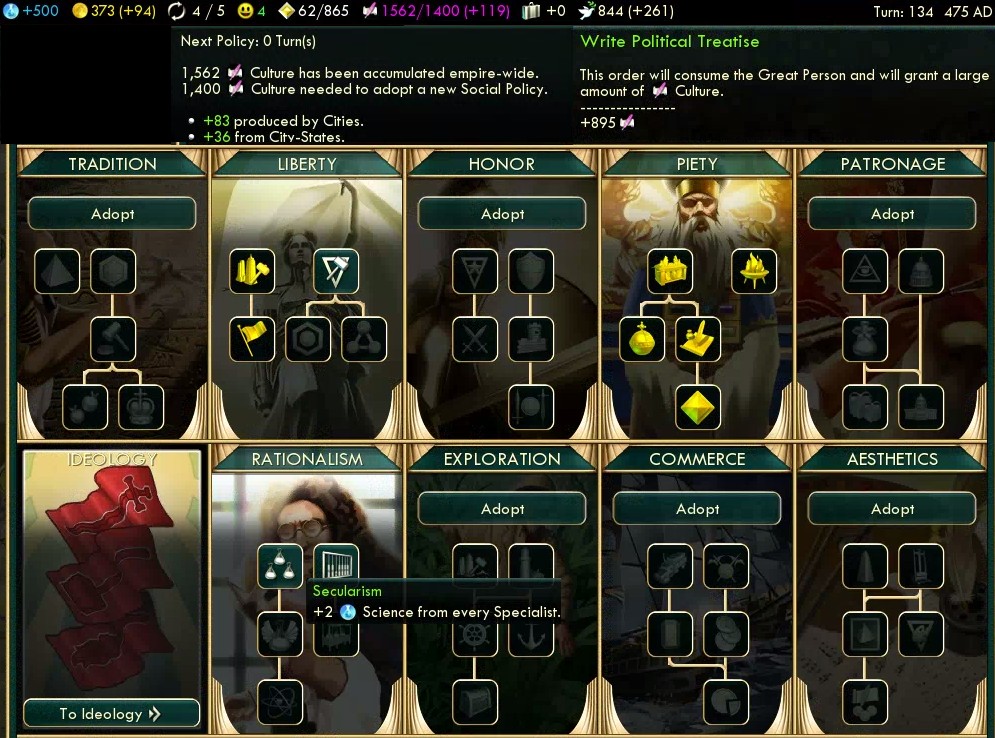
T134 came my first Great Writer. I spent him immediately, which is not my usual plan. Writers are worth considerably more if you wait until they stack up industrial-era cultured city-states and Sistine and a Golden Age. But I thought I was doing okay on culture with the pagodas, and was still desperate to catch up on tech. The timing was perfect to spend this writer right away to get Secularism eight turns sooner so I did so. That took beaker production from 500 to 600, which led to reaching the industrial age a turn sooner, which itself resulted in an extra 42 culture from city-states.

And I spent my first scientist bulb to reach Scientific Theory on turn 141. This was now tied on the same date as Poland, although they didn't spend a bulb to get here. (The Shoshone Jesuit game did spend this bulb and got here on turn 135.) I really needed to start spending my stored faith on public schools. I had now built Hagia Sophia for a prophet to raise the faith storage ceiling to 1700 (and then you can go beyond that on the turn roll when you reach the industrial age, as I set up to do here), but there wouldn't be time to cycle through yet another prophet to go higher. That 1900 faith was enough for six schools right now, and +320 would continue at exactly one per turn. Here's where the wide desert build is starting to pay off, producing 50% more faith now than Poland. Although 50% more cities do need to buy 50% more schools and labs.
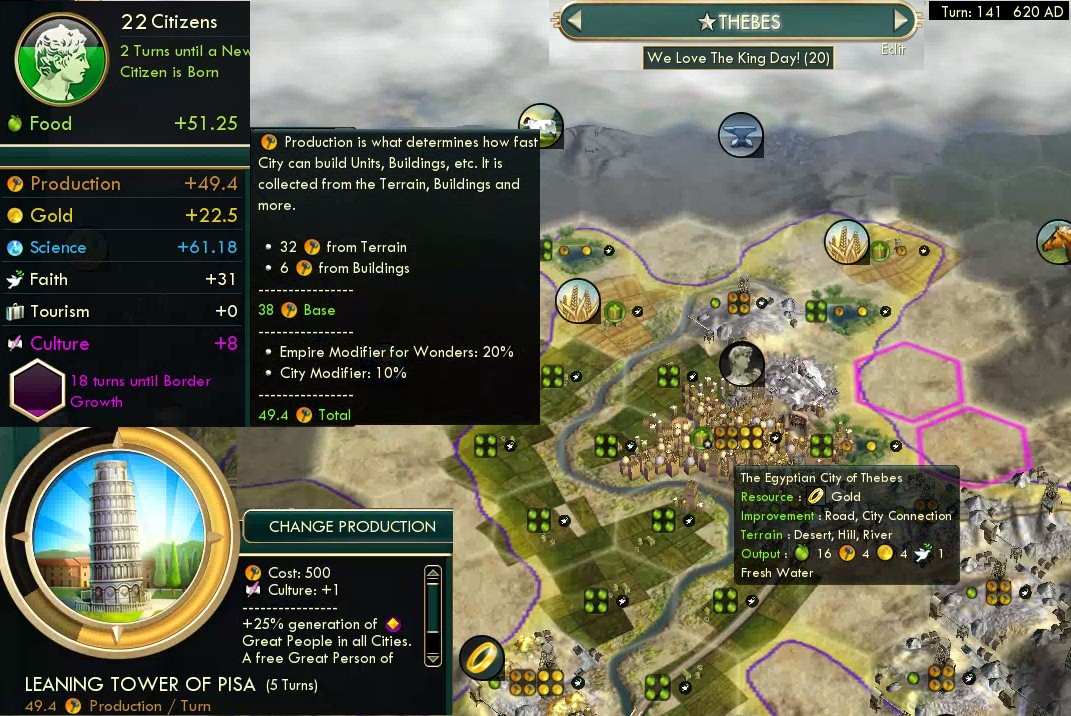
Also that bulb would accelerate Electricity. Thebes pretty desperately needed its hydro plant. It was backlogged on building several wonders (had paused Notre Dame for Leaning Tower, and still had never done National College). It was up to good size (22) thanks to plenty of flood plains and maritime food (14) and three Petra oases, but behind on hammers thanks to not really enough Petra hills (only 7.) But the hydro plant immediately accounted for 14 hammers and finally got the base up over 40 to take advantage of the shrine overflow loophole. This hammer-weak capital would add difficulty to managing the late-game builds like Statue of Liberty and Apollo, although I would make up for most of that with shrine-overflow abuse.
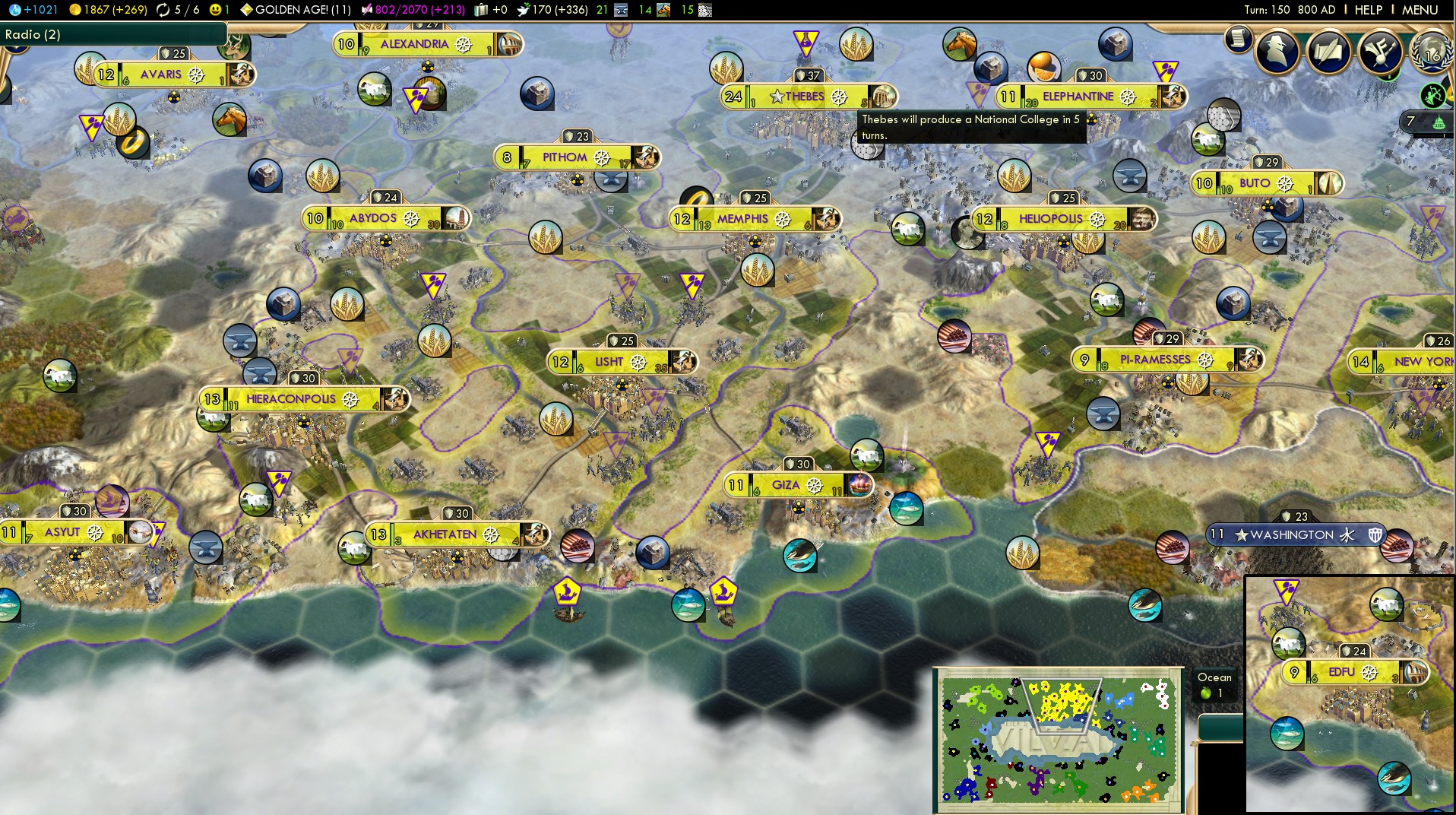
800 AD overview. Two turns to Radio is now only one behind Poland, except that we still had spent a bulb where Poland didn't. Despite the wideness, we still have exactly the same beaker production (1021 to 1020!). That's because Poland had Free Thought by now and we don't yet. I'm starting to think that really nobody can compete with Poland's midgame acceleration through Rationalism, but we'll continue to try. Also we aren't 50 beakers ahead thanks to a humiliatingly late National College finally going up in Thebes now.
At least we're finally solidly ahead of Poland in population, 187 to 158. We are behind by almost 100 gold income, but hopefully that's just because we didn't get to markets and all the trading posts yet.
My problem was just how badly delayed it felt like all the cities' build queues were. Most didn't get to aqueducts and even monuments until after universities and gardens. Workshops are coming 30 turns later than they should. This is all because the cities spent so long building extra settlers and workers to go so wide. More on this topic at the end of the report.
Turn 146 came Humanism, and finally on turn 156 Free Thought which gained another 200 beakers. Turn 159 I spent my second Great Writer for almost full value (still missing Sistine but had the other components 8 turns past) to get a badly needed Universal Suffrage. Which was also conveniently timed one turn before the Taj Mahal to extend that Golden Age.
Back to science. Turns 161 and 162 I spent two bulbs to reach Plastics, almost 8 turns past Free Thought. This was still two turns slower and one more bulb spent than Poland, but it's still quite close. I had 3400 faith saved to buy 7 labs right away, and as always filled in the rest over the next few turns. I bought one lab with cash, estimating (correctly) that was how much I could spare on the way to saving money for the spaceship parts.
Presently the beaker yield from this wide civilization finally started paying off. The second of the bulbs to Plastics provided enough overflow to 1-turn all of Chemistry, Military Science, Fertilizer, and Dynamite. The first post-Plastics bulb went for 12k beakers on Railroad and enough overflow to 1-turn all of Flight, Navigation, Archaeology, Biology.
Note that sequence of techs was deliberately off the Rocketry path (onto the top line) for two reasons. One, burning the overflow without waste into these cheap techs would work correctly now but would become progressively tougher to manage as the scientist yield approached 18k beakers later. Two, I deliberately needed to delay the Modern Era a few turns so as not to raise the faith cost for research labs yet. I eventually ended up skipping two of the labs altogether. Unlike the Poland game, this time I correctly gauged to save 2500 faith for two great scientists at the right time.
Finally I was really gaining turns over Poland. T170 bulb 14800 towards Electronics, overflow to Ballistics. T171 bulb 15200 for Radar and again for Rocketry, overflow to Satellites. These numbers definitely did overcome having spent one more bulb earlier on. As usual I set up a second strong hammer city (a coastal one with three production cargo ship routes, and bought its factory) to build Apollo while the capital did Hubble. (Order games need a third hammer city to parallelize the Kremlin too. But Freedom's Statue of Liberty comes earlier on the path to Plastics and my capital had already finished that.)
My gold income also took a long time to catch up but eventually did surpass Poland. It seemed like I was stuck around 300/turn income for a long time and I started to get a bit worried... but finally that exploded too. My developmentally-delayed cities finally got around to building markets. t169 Sovereignty from the Statue of Liberty added another 100. Between those and just continuing to add more trading posts (after Plastics I stop working food in favor of max specialists and trading posts), my income came up to over 700.
Apollo and Hubble completed in parallel from turns 172 through 180, taking advantage of shrine-rebuild abuse to save a turn or two. Turn 179 came the last regular city-spawned Great Scientist. Following that came the usual juggling of scientists and overflow and the Rationalism finisher, which all came to finishing the tech tree on t183. I had enough money for all six spaceship parts by selling the research labs, for a win on turn 184. Didn't quite beat Poland's t179, but might have with better ruins and smoother development in the early game, and a decently competitive result anyway.
Except I bumped into a different limiting factor. I fell short on culture.

I had finished Rationalism but was still two policies short of Space Procurements. Here is one significant downside of Freedom: it's useless if you don't complete it and reach the level 3 tenet, while an Order game can fall short of Spaceflight Pioneers and still do okay on manually building the parts.
I had built the Writers Guild a bit too late, although that wasn't quite a limiting factor. Even with that third regular writer plus the Globe Theater one, I would still come a few turns short on culture. I tried to handle this with another high-production coastal city to build the Sydney Opera House for that free policy, but that would still take 8 turns and not come in any faster.
My mistake had indeed been prematurely spending that first Great Writer. He went for 800 culture midgame towards Secularism instead of 2000 in the endgame, and that difference would have reached that last policy in time. I was annoyed enough at myself that I skipped playing out these last few turns again, but the win would have been on roughly turn 188.
So finally, what did this game teach me about wideness? I finally crystallized what I had only kind of intuitively understood. Cities beyond about 12 aren't good enough because their opportunity cost rises a lot more than I'd realized. The capital has a window where settlers are cheap in taking advantage of starvation and when there's nothing else drastically important to build. But then that window closes. The real cost of settlers ramps up quite drastically: maritime city-states cover the starvation, the opportunity cost becomes Petra, settlers must walk farther and longer to city sites, scavenged workers aren't enough, and you have to build happy buildings. That's why the correct wideness is somewhere around 12 cities. The opportunity cost for more really becomes high enough that they fail to pay off before the end of the game. It's not only happy that's the constraint, it's all the input that goes into building up a new city.
Well, every thing I get wrong is an opportunity to get right by playing another game...